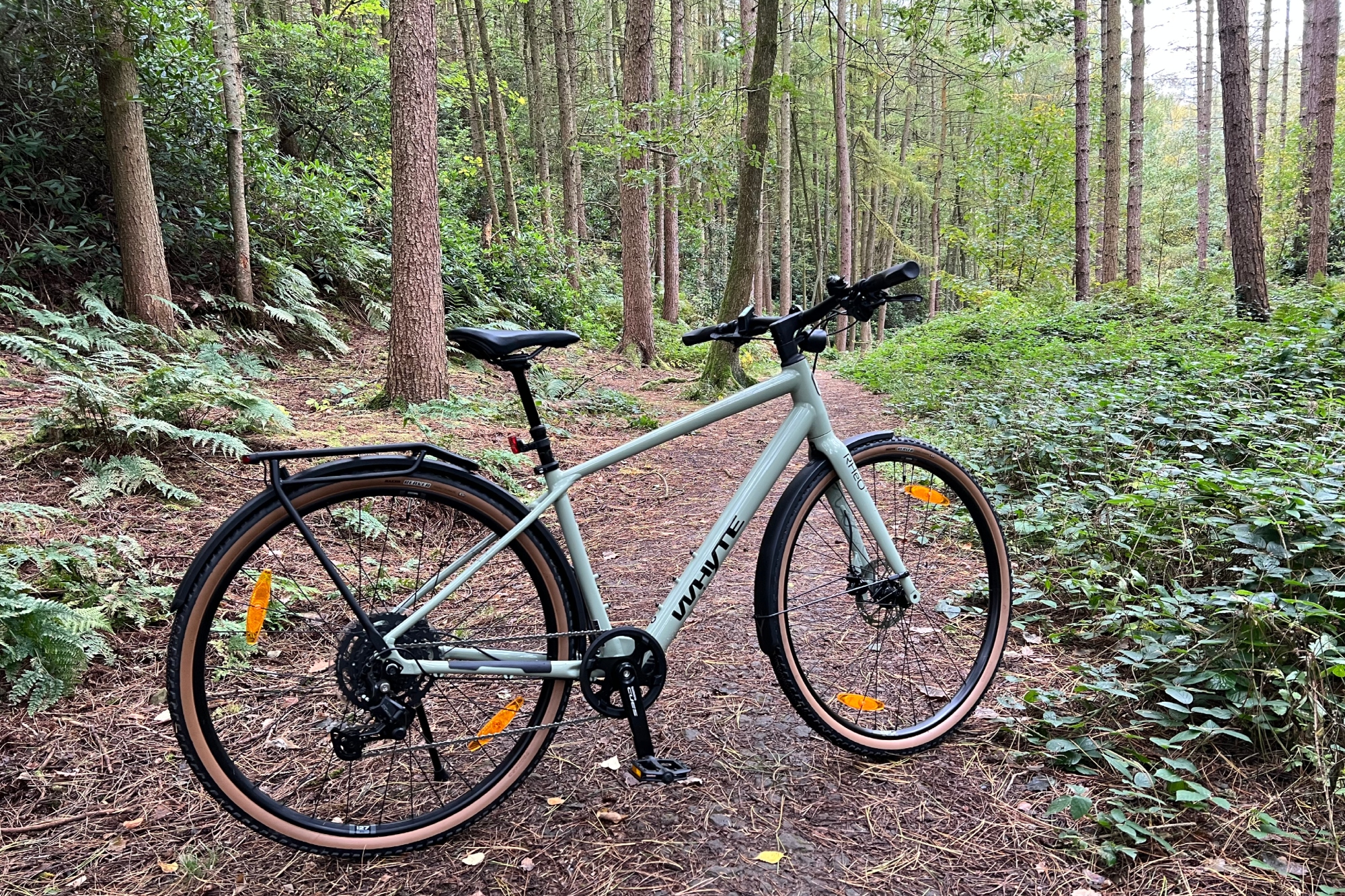Whyte Rheo 3 e-bike review: light on weight, light on torque, light on price
Can an e-city bike survive in the hills of a rural village? We put the Whyte Rheo 3 through its paces to find out.

The Whyte Rheo 3 is a surefooted, agile, versatile e-bike that makes for an easy car alternative. Integrated features ensure the bike is always ready to go, no matter the time of day or type of ride. It is as effective in hilly rural idylls as it is in flat busy towns.
-
+
450w (peak) rear hub motor
-
+
Nimble, agile, predictable steering
-
+
Build-in lights
-
+
Ready to roll with rack and mudguards
-
+
Shimano Cues 9-speed drivetrain
-
+
Lightweight compared to peers
-
+
Price point
-
-
250Wh battery provides limited range if using in hills (and cooler temperatures)
-
-
Cabling could do with a re-design at the frontend
You can trust Cycling Weekly.

Designed as a city e-bike, the Whyte Rheo 3 is packed with features to make travelling by bike as simple and as easy as possible. From integrated lights to the rear rack that's ready to load, this electric bike should make getting about town a breeze.
But what if you don't live in a town? Can all these functions still be put to use in the rural hills? I hopped on to find out if the Whyte Rheo 3 is one of the best electric bikes for any rider regardless of where they live.
Construction
At the heart of the Whyte Rheo 3 are an aluminium frame, hub-based motor and 250Wh internal battery, teamed with a straight-bladed alloy fork. This deviates from the current trend of adding front suspension and higher-range batteries to e-bikes, as seen on bikes such as the Specialized Turbo Vado, in favour of keeping the overall weight down as much as possible to a claimed 16.9kg/ 37lbs (size medium).
Whyte says that the Kynamic hub motor will deliver 450W of peak power with 45Nm torque. Comparing this again to the above Specialized, it has a smaller battery, with almost half the torque. However, according to Whyte's Cheif Designer, Ian Alexander, the Rheo 3 still delivers a high power-to-weight ratio.
Battery location has also been a key design aspect of the Rheo 3, with Alexander drawing on the brand's off-road bike experience, explaining that it's vital to get right. "You can't upgrade the frame geometry," Alexander explains, adding that the location of the battery as low as possible in the down tube creates a low centre of gravity that will ensure sure-footed handling and confident ride feel.
In terms of range, as always, it's near impossible to predict because external factors, such as speed, rider weight, terrain, and even temperature all impact performance. Whyte suggests anywhere between a 20 to 65-kilometer range, with a 3.5hr charge time from empty to full, although an after-market range extender will be available from this December.

The Rheo 3 is specced with a Shimano Cues drivetrain
The frameset and electric set-up are tied together with the respected Shimano Cues 9-speed groupset, and intriguingly a Whyte dropper seatpost, which provides 100mm drop. While not perhaps an obvious addition to a hybrid e-bike, the team behind the design say it's a very practical addition that allows you to raise and lower the saddle as you need for easy on- and offs, as opposed to assisting in tackling steep off-road terrain and gap jumps.
The bike is mounted on Whyte's own-brand wheels, with WTB STp I27 rims. Tyres are fast-rolling, wide, high-volume Maxxis Reaver Tanwall 45c rubber for a confident and comfortable ride along potholed urban streets or rough, uneven rural terrain.

The bar profile and reach and stack dimensions provide a comfortable upright ride.
Up front, the Whyte one-piece bar and stem has a 720mm width, 20mm rise, seven-degree backsweep and four-degree upsweep. Stack is 599mm and reach is 435mm for a size medium, which, in combination with the cockpit, provides an upright riding position. Alexander explains that the design borrows from contemporary mountain bike geometry to help riders feel confident with the Rheo 3's handling while ensuring a nimble front end.
The Ride

The Rheo proved just as competent in the woods as it did in the town
With its wide, chunky tyres and mountain bike aesthetics, I immediately judged the Whyte Rheo 3 as a do-all, go-anywhere electric bike. And I wasn't far wrong.
Town to rural, flat to hilly, tarmac to trails, all were tackled with the same ease as if it were purpose-built for each riding terrain.
The nine-speed Shimano Cues drive train and hub-based Kynamic motor are a great combination. Even living in a hilly location, I found that level one or two of the three pedal assist options were sufficient. Level three assist was reserved for tackling the steepest climbs, normally the ones after a dead stop when surrounded by traffic and I wanted to power out of potential harm's way.
I appreciate its responsiveness and the slight overrun of the motor 99% of the time, which prevents that jerky 'on/off' feel that was noticeable on the Mycle Cargo electric bike. However, when relying significantly on assistance up a hill, I found that if I'd neglected to knock the power levels back once at the summit, I could be slung around the next corner.
Moderating motor level before any descent is one to watch for, especially if you are a nervous rider. That said, the surefooted nature of the bike goes a long way toward building rider confidence.
Other than incapacity for human carrying, the Whyte was a close second to cargo bikes as a car replacement option. I loved the integrated setup, never having to remember to charge or attach lights, and the mudguards and rack were a great addition. My only gripe was that the cable lines cut across the front light beam. It's a quick fix for the brand, but one that I wasn't able to do without rewiring.
I found myself just hopping on the bike when I needed the headspace for a bike ride but didn't have the energy for a full outfit change or a physical workout. With the Rheo 3 I was able to pop on a pair of trainers, a warm jacket, gloves, helmet and be out of the door in just a few minutes. After a bracing ride into the hills, I could return still fresh enough to sit at the laptop without having broken a sweat.
Initially perplexing, the dropper seat post made sense when I encouraged my bike-riding novice sister to hop aboard the Whyte. Combined with the step-through frame design, the dropper seat post allowed her to feel confident with both feet on the ground when stopped, but then to adjust the height back up for a much better riding position.
Watching my sister riding the bike made me realise just how light the Whyte Rheo 3 is compared to its e-bike peers. While I found it nimble enough to manoeuvre in tight turns or gaps, my bike-riding novice sister needed to manhandle the bike more, which she did with absolute ease thanks to its lightweight.
Of course, it is lightweight because the battery is small, which hampers range. On hilly terrain and cooler days using a lot of level two assist, I was close to using 75% of the battery in only 20 miles (45km).
However, it's so lightweight that for a flat ride of 10 miles (25km), with level one assist used sporadically, and level three once to conquer the home hill, the battery remained almost full for the duration, only dropping down to 80%.
Value and conclusion
The Whyte Rheo 3 is an agile and nimble e-bike that is capable of town and rural forays. It's fast rolling and on test, I found it wasn't fazed by any terrain or topography.
It was a great addition to the household, using it for errands, enabling mixed-ability family rides and even just heading out for a refreshing cycle without the faff factor normally associated with a sweaty traditional ride.
The price of the Whyte Rheo 3 makes a distinctive mark on the e-bike market. It's low enough to give the top-end e-bike conversions, such as the Skarper, a run for their money, and has a more subtle power assist. It is also significantly cheaper than many e-bikes.
Comparing the Whyte Rheo 3 directly with the Specialized Turbo Vado, it shares similar levels of versatility but it's about a third less expensive and 10kg lighter.
Specification
- Frame and forks: 6061 alloy, 12mm thru-axle, mudguard mounts
- Drivetrain: Shimano Cues, 9 speed, 11-46t
- Motor: Kynamic hub motor, outputting 450w peak and 45Nm torque
- Battery: 250Wh internally mounted
- Brakes: Tektro T3020 hydraulic
- Seatpost: Whyte dropper 100mm drop
- Tyres: Maxxis Reaver Tanwall 700x45c
- Saddle: White custom
- Weight: 16.8 size medium (claimed)

Thank you for reading 20 articles this month* Join now for unlimited access
Enjoy your first month for just £1 / $1 / €1
*Read 5 free articles per month without a subscription

Join now for unlimited access
Try first month for just £1 / $1 / €1
Get The Leadout Newsletter
The latest race content, interviews, features, reviews and expert buying guides, direct to your inbox!
Hannah is Cycling Weekly’s longest-serving tech writer, having started with the magazine back in 2011. She has covered all things technical for both print and digital over multiple seasons representing CW at spring Classics, and Grand Tours and all races in between.
Hannah was a successful road and track racer herself, competing in UCI races all over Europe as well as in China, Pakistan and New Zealand.
For fun, she's ridden LEJOG unaided, a lap of Majorca in a day, won a 24-hour mountain bike race and tackled famous mountain passes in the French Alps, Pyrenees, Dolomites and Himalayas.
She lives just outside the Peak District National Park near Manchester UK with her partner, daughter and a small but beautifully formed bike collection.
-
 'I'll take a top 10, that's alright in the end' - Fred Wright finishes best of British at Paris-Roubaix
'I'll take a top 10, that's alright in the end' - Fred Wright finishes best of British at Paris-RoubaixBahrain-Victorious rider came back from a mechanical on the Arenberg to place ninth
By Adam Becket Published
-
 'This is the furthest ride I've actually ever done' - Matthew Brennan lights up Paris-Roubaix at 19 years old
'This is the furthest ride I've actually ever done' - Matthew Brennan lights up Paris-Roubaix at 19 years oldThe day's youngest rider reflects on 'killer' Monument debut
By Tom Davidson Published
-
 'One of the hardest races I've ever done in my life' - Tadej Pogačar finishes runner-up on Paris-Roubaix debut after crash
'One of the hardest races I've ever done in my life' - Tadej Pogačar finishes runner-up on Paris-Roubaix debut after crashWorld champion reacts to 'extremely hard' battle with Mathieu van der Poel
By Tom Davidson Published